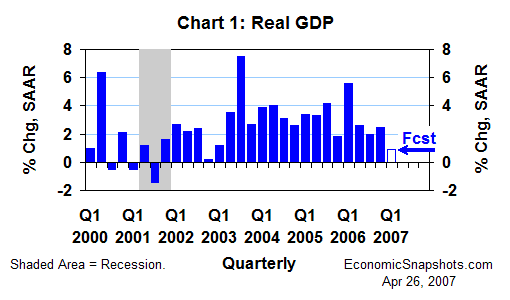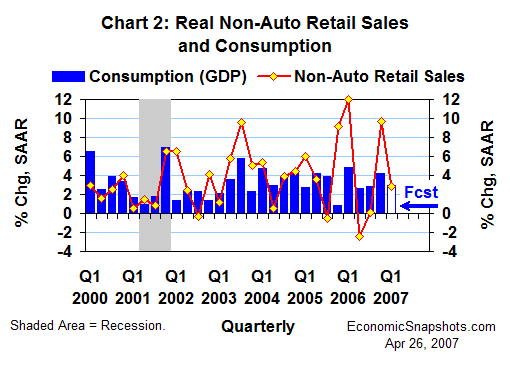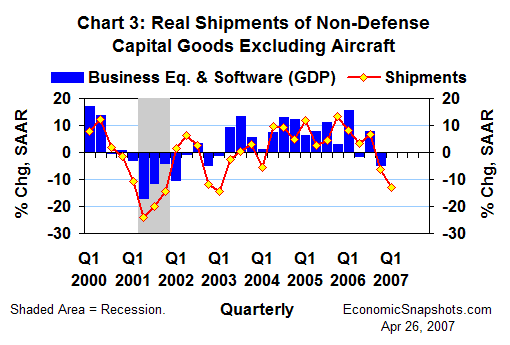
| Back to Index |
April 26, 2007 – It looks like U.S. real GDP growth (coming Friday) might have slowed to an exceptionally weak 0.9% annual rate in Q1, following a modest 2.5% increase in Q4 (Chart 1).

Real consumption growth probably slowed to about a 2.9% annual rate in Q1, compared to a Q4 gain of 4.2% (Chart 2).

Light vehicle sales edged up slightly in Q1, rising by 0.2M units to a 16.5M unit annual rate. But, the sharp deceleration in real non-auto retail sales should dominate the pattern of Q1 consumption growth. Real non-auto retail sales rose at a 2.8% annual rate in Q1, compared to a 9.7% increase in Q4.
Despite the anticipated slowing, real consumption seems to have continued to grow in Q1. That’s more than we can say for real fixed investment growth.
Real shipments of non-defense capital goods excluding aircraft fell at a 12.8% annual rate in Q1 after falling by 6.4% in Q4 (Chart 3). Thus, we seem to be due for another decline in real business fixed investment in equipment & software in Q1. In Q4, this real GDP component fell at a 4.8% annual rate.

Based on data through February, real residential construction spending probably came close to matching Q4’s steep 19.8% drop in Q1. That should more than offset the Q1 gains that seem to be shaping up in real non-residential construction.
Putting these pieces together, total real fixed investment (business equipment & software plus residential and non-residential construction) might have come close to matching Q4’s 9.1% drop.
In Q4, real net exports rose by an extra-sharp $46.2B (chained 2000 dollars), adding a big 1.6 percentage points to that quarters’ real GDP growth. At the same time, an extra sharp $33B reduction in Q4 real inventory growth reduced real GDP growth by 1.2 percentage points – offsetting much of the positive net export effect.
Based on data through February, both net exports and inventories seem to have mostly unwound these Q4 developments in Q1, implying reversed, but still largely offsetting contributions to Q1 real GDP growth.
Real government spending (always a wild card) rose at a 3.4% annual rate in Q4, compared to growth averaging 2.7% per quarter for all four quarters last year. In line with that trend, this forecast assumes somewhat slower real government spending growth in Q1.
Suzanne Rizzo